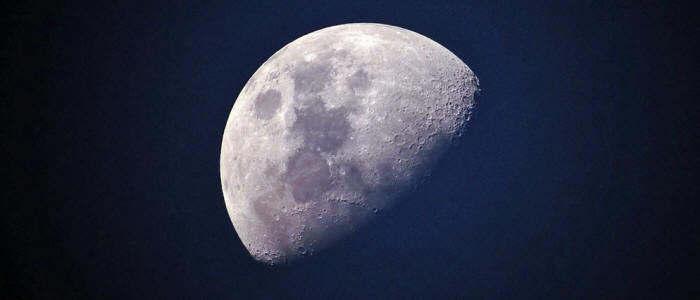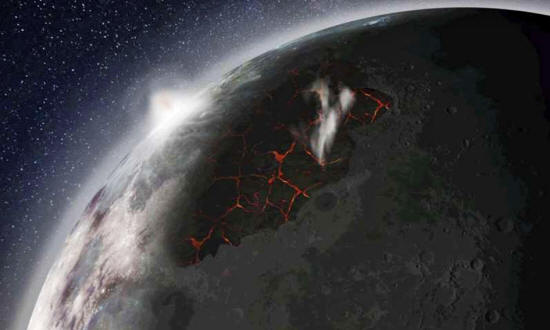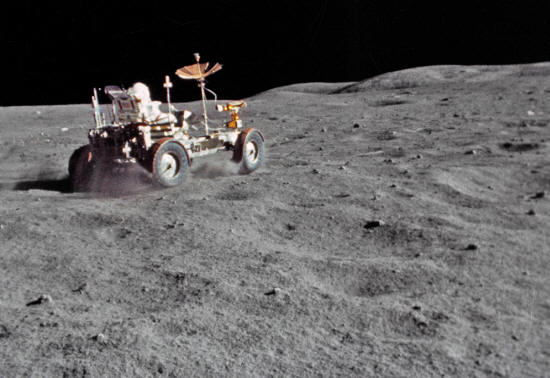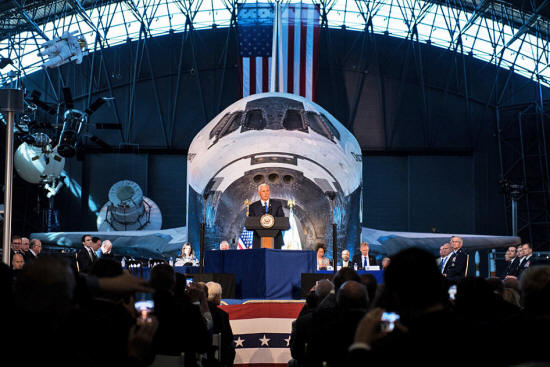|

by Karla Lant
October 07,
2017
from
Futurism Website

In Brief
New research
on samples from the Apollo missions shows that
our Moon had an atmosphere 3 to 4 billion years
ago.
The research
suggests that there may already be a source of
ice on the Moon that astronauts and colonists
can use.
To the Moon
New research shows
that our Moon once had an atmosphere 3 to 4 billion years ago (Lunar
Volcanism Produced a Transient Atmosphere Around the Ancient Moon).
It formed when
volcanic eruptions rocked the ancient satellite, propelling gases
above its surface too rapidly for them to seep into space. The
surface of the Moon is peppered with impact basins filled with
volcanic basalt.
These basalt
plains, called
maria, were formed when plumes
of magma from inside the Moon erupted to the surface, creating lava
flows.
Astronauts from
the Apollo missions brought back
samples from the maria to Earth, and we now know that the
lava flows contained carbon monoxide and other gas components,
sulfur, and even the building blocks of water.
Our Moon has no
atmosphere now, as it lacks a strong enough magnetic field and
sufficient mass to hold an atmosphere around it.
Unlike Earth, which has sufficient
mass and magnetism to hang on to an atmosphere, any atmosphere
around the Moon would quickly be stripped away by solar winds.
However, the new
research indicates that the Moon did briefly have an
atmosphere before that happened.

Image Credit:
NASA MSFC
The team used the
samples to calculate how much gas rose and accumulated to form the
transient atmosphere.
They found that the
volcanic activity peaked about 3.5 billion years ago, which was when
the atmosphere was at its thickest. Once it formed, it persisted for
around 70 million years before it was stripped away and lost in
space.
During the period
when the Moon had an atmosphere, it was almost three times closer to
Earth, and therefore would have appeared much bigger in the sky.
Boots On the Moon
Universities
Space Research Association (USRA) Senior Staff Scientist
David Kring
told Phys.org,
"This work
dramatically changes our view of the Moon from an airless rocky
body to one that used to be surrounded by an atmosphere more
prevalent than that surrounding Mars today."

Image Credit:
Debra Needham
This new
information has important implications for future
astronauts,
planned lunar missions and
space exploration.
The
research suggests that volatiles from the atmosphere may
have been trapped near the lunar poles in cold, permanently
shadowed areas. If this is true, there may already be a
source of ice on the Moon that astronauts and colonists can
use for drinking water, growing food, and other needs.
Icy
deposits stocked with captured volatiles could also provide
fuel and air for both lunar surface operations and even
missions beyond the Moon.
And
whatever already exists on the Moon won't need to be ported
from Earth - a tremendous advantage given the expense of
carrying cargo into space.
The U.S. Officially says They are...
Sending Humans to the Moon
by Kyree Leary
and Brad Bergan
October 05, 2017
from
Futurism Website

NASA
In Brief
Vice President Mike Pence took to The
Wall Street Journal to explain how the U.S. will
regain the top spot in space exploration.
While not fully
detailed, the plan is to get people to the Moon
before becoming the first nation to put humans
on Mars.
The Return of the Moon
Earlier this month,
NASA said it was prepared
to shift its focus away from Mars,
and toward
the Moon, whenever the current
administration gave the "go" for logistical launch.
Now the
organization will have to put their plans into motion, because the
present administration just announced a renewed effort to get back
to the Moon, and beyond.
In an op-ed
published to
The Wall Street Journal on
October 4, Vice President Mike Pence explained an executive
order had been signed to restore the National Space Council, with
him as its head.
"On Thursday
the council will hold its first meeting in nearly 25 years, and
as its chairman, I will deliver a simple message: America will
lead in space again," he said,
...citing
the national space policy's lack of a coherent vision as the reason
the U.S. has been left behind, while countries
like China and Russia move forward
with their own plans.
Pence also
explained how desperately the U.S. needs technology of its own in
space, to protect its surveillance, communication, and navigation
systems from hacking attempts.
But What About Mars?
The ostensible goal
is human exploration.
However, Pence
believes starting with the Moon and establishing a firm presence on
Earth's nearest neighbor, as "a vital strategic goal," ought to come
first.
This isn't the
first time the Moon has taken precedence as first step to missions
advancing farther into the solar system.
In
August, former astronaut Chris Hardfield said settling on the
Moon should come first, as it would prove we can still get there.
The promise is that our travels won't end there.
According to the
VP, the U.S. intends to be the first country to send people to Mars.
However, the impetus for space expansion here seems to be
exclusively commercial, rather than exploratory or scientific.
"In the years
to come, American industry must be the first to maintain a
constant commercial human presence in low-Earth orbit, to expand
the sphere of the economy beyond this blue marble, " added Pence

VP Mike Pence
speaking at the first National Space Council meeting.
Image Credit: NASA
Within the
next few weeks, the administration will form a Users'
Advisory Group comprised of various leaders in the
commercial space industry.
As its name
suggests, it's largely meant to option the expertise of
those whom have been developing new hardware and technology
to get people into space, either for learning or commercial
purposes.
Indeed, as
Pence put it,
"Business is leading the way on space technology, and we
intend to draw from the bottomless well of innovation to
solve the challenges ahead."
The VP
didn't detail who would be in this group, though,
...are
a couple of people that come to mind.
Elon Musk
just recently detailed new plans to send people to Mars in
2024, while Blue Origin intends to send people into
suborbital space starting next year.
It may be
some time before we see what the National Space Council
comes up with.
While NASA
has shared its plans for getting to the Moon and Mars, the
organization was noticeably absent from the Vice President's
announcement.
Critics of
NASA's pattern of incoherent plans to get us to Mars like
Dr. Robert Zubrin, former Lockheed Martin
Astronautics engineer and president of Pioneer
Astronautics, have pointed out that
Moonbases and low-Earth
orbit missions are designed to diversify mission functions
so as to garner funding for under-used or unnecessary
departments, rather than actually get us to Mars...
If you want
to string a rope from A to B, a straight line isn't best if
you're a rope salesman.
Whether
NASA's absence signifies a change in plans or not, the
coming years are sure to be the most interesting in U.S.
space travel history since the 1960s.
|






